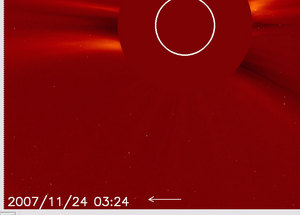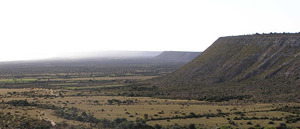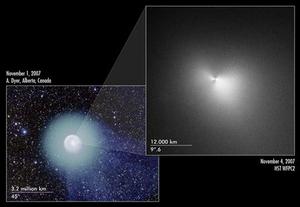It's such a simple idea that it's surprising no one seems to have thought of it before. Did a massive asteroid or comet impact kick-start plate tectonics on Earth?
For much of our planet's history, rocky plates have been sliding over a viscous, molten mantle, colliding to build mountain ranges or spreading apart to make way for oceans. In a neat piece of recycling, an oceanic plate dives, or "subducts", underneath a less dense continental plate, and eventually melts into the hot mantle.
Geologists estimate that plate tectonics began during the Archean period, between 2.5 and 3.8 billion years ago - but they don't know what triggered it. Ancient Earth was too hot for the crust to solidify completely, and the lightest minerals would have floated to the surface over the entire planet, making the subduction of denser plate material unlikely.
Jan Pomierny
SOHOFri, 30 Nov 2007 04:44 UTC
Michal Kusiak, a student of astronomy at Jagiellonian University in Krakow and an editor of Astronomia.pl has discovered a new comet. This young astronomy enthusiast found the object in images sent back to Earth by the SOHO Solar Observatory. Information on the discovery has been already published on a Web Site of the British Astronomical Association.

|
| ©SOHO
|
| Comet belonging to the Kreutz family
|
Scientists at the Mount Palomar Observatory in California and Caltech have confirmed that the "blast front" from Comet 17P/Holmes will hit the Earth on Dec 21, 2012. By odd coincidence, this is the day that the Mayan Calendar ends, and is predicted by some to correlate with the end of the world.
The serpent's tails coil together menacingly. A horn juts sharply from its head. The creature looks as if it might be swimming through a sea of stars. Or is it making its way up a sheer basalt cliff? For Bruce Masse, an environmental archaeologist at Los Alamos National Laboratory, there is no confusion as he looks at this ancient petroglyph, scratched into a rock by a Native American shaman. "You can't tell me that isn't a comet," he says.

|
| ©Discover
|
| The Fenambosy chevrons at the tip of Madagascar. Image courtesy of Dallas Abbott
|
NASAThu, 15 Nov 2007 00:00 UTC
NASA's Hubble Space Telescope has probed the bright core of Comet 17P/Holmes, which, to the delight of sky watchers, mysteriously brightened by nearly a millionfold in a 24-hour period beginning Oct. 23, 2007.
But what's a Comet, anyway?

|
| ©REUTERS/NASA, ESA, and H. Weaver/The Johns Hopkins University Applied Physics Laboratory/Handout
|
| A Hubble image (R), taken November 4, 2007, shows the heart of Comet 17P/Holmes. The central portion of the image has been specially processed to highlight variations in the dust distribution near the nucleus. About twice as much dust lies along the east-west direction (the horizontal direction) as along the north-south direction (the vertical direction), giving the comet a "bow tie" appearance. The composite color image at left, taken on November 1, 2007, by an amateur astronomer shows the complex structure of the entire coma, consisting of concentric shells of dust and a faint tail emanating from the comet's right side. The normally sedate Comet Holmes made a bright splash in the sky about two weeks ago, unexpectedly becoming a million times brighter than normal overnight and causing a stir among astronomers.
|
Scientists at Cardiff University, UK, believe they have discovered the cause of crop failures and summer frosts some 1,500 years ago - a comet colliding with Earth.
The team has been studying evidence from tree rings, which suggests that the Earth underwent a series of very cold summers around 536-540 AD, indicating an effect rather like a nuclear winter.
The scientists in the School of Physics and Astronomy believe this was caused by a comet hitting the earth and exploding in the upper atmosphere. The debris from this giant explosion was such that it enveloped the earth in soot and ash, blocking out the sunlight and causing the very cold weather.
This effect is known as a plume and is similar to that which was seen when comet Shoemaker-Levy-9 hit Jupiter in 1995.
Historical references from this period - known as the Dark Ages - are sparse, but what records there are, tell of crop failures and summer frosts.
Julie Steenhuysen
ReutersThu, 15 Nov 2007 23:10 UTC
The normally sedate Comet Holmes made a bright splash in the sky about two weeks ago, unexpectedly becoming a million times brighter than normal overnight and causing a stir among astronomers.

|
| ©REUTERS/NASA, ESA, and H. Weaver/The Johns Hopkins University Applied Physics Laboratory/Handout
|
| A Hubble image (R), taken November 4, 2007, shows the heart of Comet 17P/Holmes. The central portion of the image has been specially processed to highlight variations in the dust distribution near the nucleus. About twice as much dust lies along the east-west direction (the horizontal direction) as along the north-south direction (the vertical direction), giving the comet a "bow tie" appearance. The composite color image at left, taken on November 1, 2007, by an amateur astronomer shows the complex structure of the entire coma, consisting of concentric shells of dust and a faint tail emanating from the comet's right side.
|
Formerly, the Sun was the largest object in the Solar System. Now, comet 17P/Holmes holds that distinction.
Comment: The same image is available from the University of Hawaii as a
300 dpi tif file.


Comment: Enjoy our latest Forum's Topic:
Speculations about the Comet 17P/Holmes